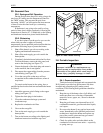
Page 28
4F-5. High Elevation Operation
The venturi combustion flow system completely
compensates for installation at elevations other than
sea level. Gas orifice changes are not necessary. Unlike
conventional systems with open type burners and
positive pressure regulators, the gas orifice differential
pressure is created by the air flow, and it is
automatically reduced when air density decreased. A
Hi-E2 heater commissioned at sea level will operate at
nearly the same air/gas mixture when operated at
higher elevation. Its firing rate will decrease about 3%
per 1000 feet due to the barometric pressure change.
In servicing a Hi-E2 heater at high elevation be
aware that the input will be naturally reduced by this
amount and that the differential pressures, as discussed
in prior sections, will also be reduced. Pressure
readings at various elevations will be approximately as
follows:
Elevation Gas Orifice Unfired Venturi
Ft (m) Differential Differential
Sea Level 4.0" (102 mm) WC 4.7" (119 mm) WC
2000 (610) 3.7 (94) 4.3 (109)
4000 (1220) 3.4 (86) 4.0 (102)
6000 (1830 3.2 (81) 3.7 (94)
8000 (2440) 2.9 (74) 3.5 (89)
10000 (3050) 2.7 (69) 3.2 (81)
The gas pressure offset is determined by the
regulator spring adjustment, not air density. It is not
affected by elevation change.
4G. Combustion Condensate
The condensate disposal system of the Hi-E2 pool
heater is quite simple, but must be properly installed
and maintained. See the installation instructions for
information on correct tubing installation. Condensate
drainage should be observed routinely and if necessary,
the flow-ways should be cleaned.
In normal operation, condensate drains from the
condensate collector behind the combustion fan. A 5/8"
I.D. drain tube conducts this water into the condensate
trap/neutralizer, where a “water seal” prevents room
air from being pulled into the system. A smaller
amount of condensate may drain from the vent duct
and blower. The water seal of the trap prevents vent
gases from being discharged into the room. See Figures
11 and 12 in the Condensate Disposal section of the
installation instructions.
During start-up, condensate from the collector
cannot reach the trap unless the water seal is
established. This can be done by pouring water into the
trap. The heater will self-prime by driving water into
the vent outlet, from which it will eventually drain into
the trap. However, it is better to avoid this by manually
priming the trap.
Correct any such problems and verify normal
operation by returning to the venturi system checkout
procedures.
Pressure readings will be less if the heater is
located at an elevation significantly above sea level.
4F-3b. Flow in Heater and Vent
If the venturi inlet pressure reading is normal (or
less than normal), flow may be blocked within the
heater or in the exhaust venting, or the combustion
blower may be operating below standard. To evaluate
this, connect the negative side of the manometer to the
collector pressure tap, as shown in Figure 38, leaving
the positive side open to ambient (This requires a
pressure tap with a 1/4" NPT thread). When the heater
is operating, the pressure at this location should be
about 3.5 ± 0.5" WC less than ambient for a model
220 and 2.8 ± 0.5" WC less than ambient for a model
350. If a greater reading is observed (i.e. more
negative), flow is restricted within the heater, most
likely at the burner or the heat exchanger. If the
reading is substantially less (i.e. less negative), the
combustion blower is not operating properly or flow is
blocked after the blower, possibly in the vent. Correct
any such problems and verify normal operation by
returning to the venturi system checkout procedures.
Pressure readings will be less if the heater is
located at an elevation significantly above sea level.
4F-4. Fuel Gas Type and Gas Orifice Size
The Hi-E
2 venturi combustion system requires
only a gas orifice change to change from natural to
propane gas or vice-versa. Required venturi system
and gas pressures are the same for either gas. Required
gas orifices are listed in the replacement parts list.
Teledyne Laars configures its heaters for natural gas
with 0.60 specific gravity and 1035 Btu/Ft
3
or for
propane gas with 1.52 specific gravity and 2500 Btu/
Ft3. Consult your Teledyne Laars representative if the
available gas is substantially different.
Figure 38. Collector Pressure Measurement


















